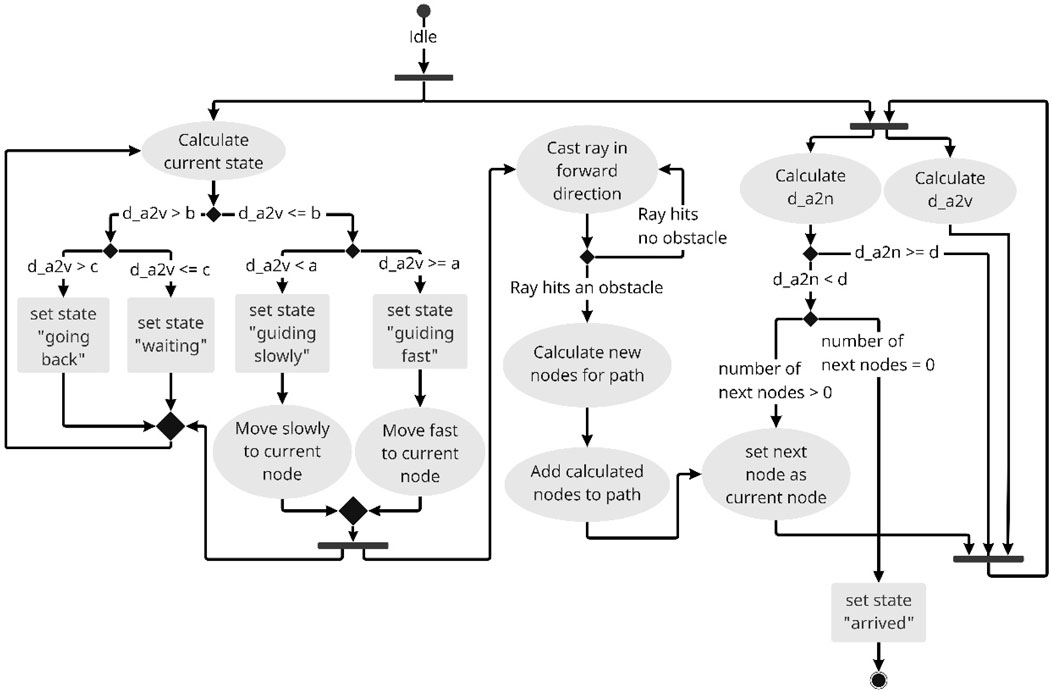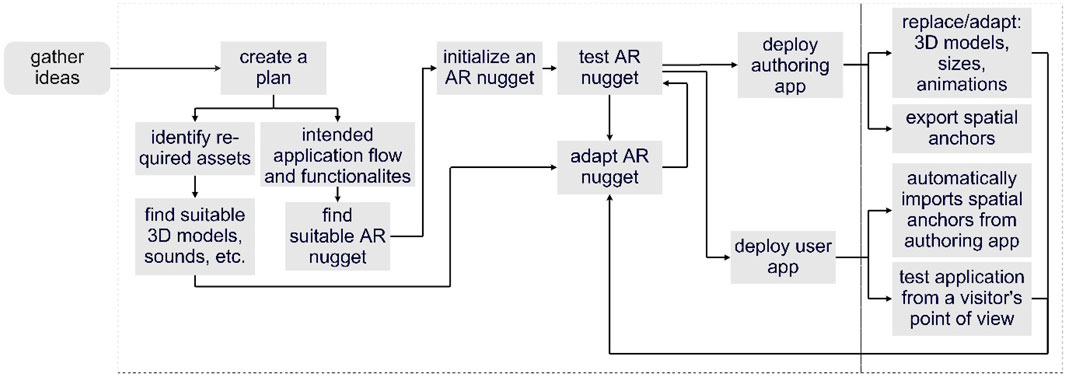
95% of researchers rate our articles as excellent or good
Learn more about the work of our research integrity team to safeguard the quality of each article we publish.
Find out more
ERRATUM article
Front. Virtual Real. , 21 June 2023
Sec. Technologies for VR
Volume 4 - 2023 | https://doi.org/10.3389/frvir.2023.1236765
This article is an erratum on:
Supporting the creation of non-linear everyday AR experiences in exhibitions and museums: An authoring process based on self-contained building blocks
by Rau L, Bitter JL, Liu Y, Spierling U and Dörner R (2022). Front. Virtual Real. 3:955437. doi: 10.3389/frvir.2022.955437
Due to a production error, Figures 1, 2 have been included in the article in the wrong order. Figure 1 should be listed as Figure 2, and Figure 2 should be listed as Figure 1. The figures in the correct order appear below.

FIGURE 1. State diagram of the guiding state machine, showing how the agent behaves based on the distance between it and the visitor (d_a2v) and the distance between it and the current node (d_a2n). Authors can configure the agent’s behavior using the parameters a—d. The states “going back,” “waiting,” “guiding slowly,” and “guiding fast” are accessedd based on a, b and d_a2v. If the agent detects an obstacle on the path, it calculates new nodes and adds them to the path. When it arrives at a node, it starts to move to the next node. If there are no more next nodes, the state is set to “arrived”.

FIGURE 2. Flowchart of the authoring process and its two phases. Authors start with process-specific tasks in phase 1. They use Unity and our authoring tools to adapt their AR nuggets and to deploy an authoring as well as a user application. In phase 2, authors use an AR device to perform location-specific authoring tasks like placing and scaling augmentations or testing the AR experience from a visitor’s point of view. The authoring process is iterative and authors might go back to phase 1 to further adapt their AR nuggets.
The publisher apologizes for this mistake. The original version of this article has been updated.
Keywords: augmented reality, museum, authoring tools, non-linear, everyday experience, navigation, patterns, authoring
Citation: Frontiers Production Office (2023) Erratum: Supporting the creation of non-linear everyday AR experiences in exhibitions and museums: an authoring process based on self-contained building blocks. Front. Virtual Real. 4:1236765. doi: 10.3389/frvir.2023.1236765
Received: 08 June 2023; Accepted: 08 June 2023;
Published: 21 June 2023.
Approved by:
Frontiers Editorial Office, Frontiers Media SA, SwitzerlandCopyright © 2023 Frontiers Production Office. This is an open-access article distributed under the terms of the Creative Commons Attribution License (CC BY). The use, distribution or reproduction in other forums is permitted, provided the original author(s) and the copyright owner(s) are credited and that the original publication in this journal is cited, in accordance with accepted academic practice. No use, distribution or reproduction is permitted which does not comply with these terms.
*Correspondence: Frontiers Production Office, cHJvZHVjdGlvbi5vZmZpY2VAZnJvbnRpZXJzaW4ub3Jn
Disclaimer: All claims expressed in this article are solely those of the authors and do not necessarily represent those of their affiliated organizations, or those of the publisher, the editors and the reviewers. Any product that may be evaluated in this article or claim that may be made by its manufacturer is not guaranteed or endorsed by the publisher.
Research integrity at Frontiers

Learn more about the work of our research integrity team to safeguard the quality of each article we publish.